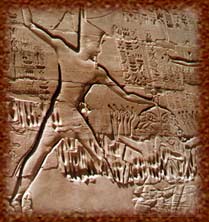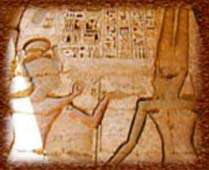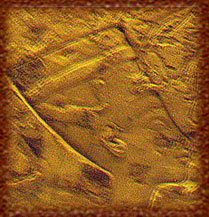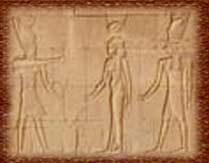| Development
of Ancient Egyptian Art |
The
novelty of the scene resides in one single element: horses,
and by extension, chariots. Horses and chariots were introduced
to Egypt by the Hyksos invaders. Never before had Egyptians
has such creatures, but they realised quickly the advantage
of breeding such splendid animals. From then on, the military
prowess of the king adorned the walls of temples and tombs.
|
Seti the First smiting enemies from the 19th Dynasty
found in Karnak
|

Credits: Jackie Jay |
Queen
Hatschepsut's reign (Eighteenth Dynasty) was one of peace
and formidable artistic activity. Her majestic funerary temple
at Deir el-Bahari is an architectural jewel and the reliefs
decorating the various rooms, such as her trading expedition
to the mysterious land of Punt, are perfectly executed and
extremely detailed. Even the class of fish depicted in the
river can be identified by biologists! A trip to Egypt is
incomplete without a day expedition to Deir el-Bahari.
Although the king was now a military leader, he nevertheless
did not neglect his priestly duties. Regularly, he was depicted
making offerings and libations to Amun, the national god of
the New Kingdom, and various other deities of the pantheon.
Pharaoh was also depicted fraternising with the gods, as he
was considered as their equal after death. Such scenes were
present in the Old and Middle Kingdoms, but since temples
and shrines of those epochs have not survived as well as those
of the New Kingdom, there are less reliefs and paintings of
that nature. Indeed, by the Middle Kingdom, Old Kingdom temple
reliefs were already falling into decay, and remaining structures
still standing were demolished under Eighteenth and Nineteenth
Dynasties in order to obtain good quality construction material!
|
Ramses the Third serving Amun from the 20th Dynasty
found in Karnak
|

Credits: EgyptVoyager |
Private
tombs of the New Kingdom were decorated with paintings as
colourful as those of the Old Kingdom. The deceased and his
family were depicted in their everyday life activities as
well as banquet scenes, and excerpts from the Book of the
Dead were also painted on the walls. Scenes from the Book
of the Dead showed the journey of the deceased to the Afterlife
such as the Judgement of the Dead, where the heart of the
deceased is weighed against the feather of Maat, and so forth.
New Kingdom Egyptians dressed differently from their ancestors
from the Old and Middle Kingdoms. Men and women both sported
quite elaborate long, diaphanous, pleated gowns with sleeves,
as well as ordinary kilts and tight sheet dresses. New Kingdom
women generally wore their hair long, although there was a
shorter hairstyle in vogue at the time, and, previously unseen,
earrings. Men also had short or shoulder length hair and nobles
were also known to wear earrings.
|
Queen Nefertari, Ramses the Great's wife from the 19th
Dynasty ; Facsimile of Nefertari's tomb paintings in
the Harrer Collection, San Bernardino, California
|

Credits: Dana Bisping |
|

|
Like
Old Kingdom kings, New Kingdom pharaohs had delusions of grandeur
and the well being of economy during the New Kingdom permitted
them to indulge in such artistic folly. Instead of building
pyramids, they built magnificent temples of incredible proportions
as well as absolutely gigantic statues. Ramses the Great was
by far the most prolific builder (although not the only one)
and the size of his monuments renders one breathless! Massive
architecture and monumental sculptures, such as Ramses' rock-cut
temple at Abu Simbel (Nubia), were important political standpoints
reasserting the king's power.
Amarna
Period
The
Amarna period is, without any doubt, the most surprising period
in ancient Egyptian history. Akhenaton's religious revolution
had serious repercussions in Egyptian art since the promotion
of Aten as the sole god not only rejected all the other gods
of the pantheon, but the entire mythology associated with
them. Any scenes depicting other gods or any reference to
Osiris and the cult of the dead were proscribed.
New scenes that decorated tombs, stelae, and the Aten temple
at Karnak (dismantled and recycled in later construction projects)
broke with artistic conventions and traditions, since Aten
itself had no mythology of its own. Akhenaton, Nefertiti,
and the princesses were the only people to allowed to worship
Aten, and they were depicted making offerings of raising their
hands in praise in front of the solar disk with arms that
represented their god. New, quite expressive, family scenes
taking place under the solar disk also decorated walls: Akhenaton
and Nefertiti sit together (sometimes Nefertiti on her husband's
lap) cajoling and playing with their daughters - a most unusually
display of affection in Egyptian art.
Decoration
of private tombs rarely included scenes of everyday life,
hunting, fishing and fowling, or even banqueting. The limited
artistic repertoire was entirely focused on Akhenaton and
his family. Loyal subjects were depicted almost literally
throwing themselves on their belly, prostrating before the
King and his family as they appeared in public. Since they
could not worship Aten, they worshipped Akhenaton and his
family. Akhenaton rewarded worthy courtiers by throwing them
gold from a 'window of appearance,' where he stood with his
family.
Akhenaton and his family dressed in the regular New Kingdom
fashion, although Nefertiti did sport a new type of headdress.
However, apart from the unconventional scenes, the most disturbing
difference in Amarna art resides in the physical appearance
of Akhenaton, his wife and his daughters. Their elongated
craniums, drooping features, long necks, pot bellies, large
hips and thighs, spindly arms with spidery digits, and short
legs have left Egyptologists wondering as to the exact reason
for this most unusual portraiture.
|
Nefertiti from the 18th Dynasty (Amarna Period) found
at the Royal Ontario Museum
|

Credits: Caroline Rocheleau |
Late
Period
Various
dynasties - some of which were not even Egyptian - ruled Egypt
during the Late Period, the most important (and interesting)
being the Twenty-Fifth and Twenty-Sixth Dynasties. The Twenty-Fifth
Dynasty pharaohs were Nubians, the same Nubians who had lived
for so long under Egyptian domination. In fact, the Nubians
were almost more Egyptian than the Egyptians themselves! They,
like the Libyans and Persians who also ruled Egypt during
the Late Period, did not bring any stylistic changes in Egyptian
art. Except for the occasional lesser degree of execution,
their art resembled and followed New Kingdom style in every
way possible. The Twenty-Sixth Dynasty, however, opted for
a return to Middle Kingdom art style, a renaissance or revival
of the so-called classical Egyptian art. Accurate and skilled
copies of Middle Kingdom sculptures and reliefs make it difficult
for Egyptologists to differentiate and ascribe pieces to the
correct period.
All in all, even though Egypt did not have the powerful political
leaders it once had, it remained rooted enough in tradition
for its art to survive virtually intact for seven centuries.
Greco-Roman
Period
The Greeks who ruled Egypt after the death of Alexander the
Great evidently found Egyptian art quite attractive considering
they adopted ancient Egyptian artistic conventions but changed
the entire administrative system, declared Greek the official
language of the country, and moved the capital all the way
north to Alexandria, the new city Alexander had had built.
The Greeks supported an extensive building programme, and
the pylons and walls of the various temples they built at
Philae, Edfu, and Dendera, for example, are all covered with
sculptured reliefs that follow traditional conventions and
the square-grid of 21 and a quarter units adopted during the
Twenty-Sixth Dynasty.
|
Greco-Roman Pharaoh offering to Hathor and Horus from
the Greco-Roman Period found in Denderah
|

Credits: EgyptVoyager |
The
Romans, however, often altered Egyptian art to such an extent
that it can barely be recognised as Egyptian. It is with Roman
influence that Egyptian art truly died. The glorious Pharaonic
civilisation was soon to follow.
(Caroline
Rocheleau)
|
|